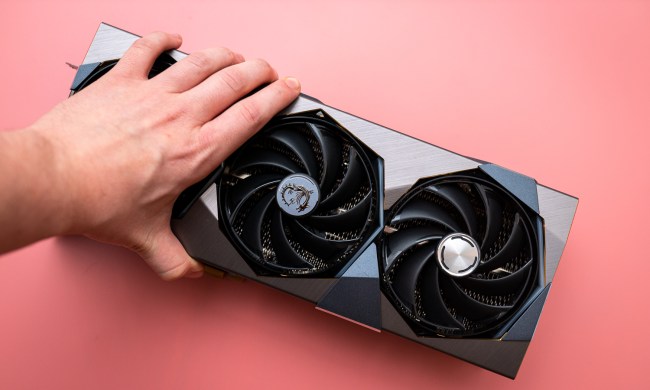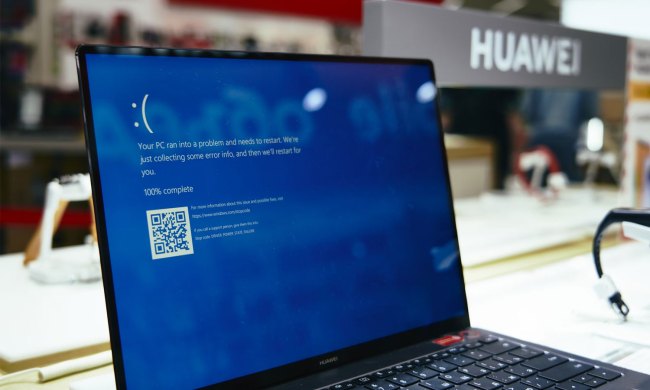
“The Samsung Xpress C1860FW has almost all the features we want, but the lack of duplexing at its high retail price point really drags down the score.”
- Fast prints
- Great-looking output
- Excellent connectivity
- Expensive for home use
- Toner replacement costs are high
- No duplexing
In most households, affordable inkjet-based printers are normally what you’ll find. But there are times when you want the crispness and feel of laser printing, such as people who run a small business from home. The Samsung Xpress C1860FW ($643 retail, but the street price is significantly less) is a laser-based option that would meet those users’ needs: It produces really good-looking output, has a gorgeous touch-sensitive control panel, and, while it towers over anything else on your desk or table, has a manageable footprint. It has great connectivity options, and spits out pages at an impressive rate.
But home users will most likely find the price premium hard to swallow, and for use in a small business environment – whether in a home or office – the C1860FW lacks an essential productivity feature, duplexing.
Features and design
There’s no mistaking the C1860FW for a laser printer – a laser multifunction printer, to be exact. It won’t get inducted into the Museum of Modern Art, but it’s an attractive gray and black unit nonetheless, with the scanner/automatic document feeder (ADF) mounted above where the printed-paper exits. Despite a seemingly overbearing presence, the C1860FW actually has a small footprint – only 16.5 x 16.8 inches and stands 17.6 inches high. Make a home for it, because at 47 pounds you won’t want to move it around a lot.
The omission of auto-duplexing is a real feature gap for its intended users, especially considering the price.
The control panel takes up almost the full width of the unit. One of the reasons for this is an impressive 4.7-inch color LCD touch-panel that’s easy to navigate and makes using the device intuitively simple. To the right of the display is a numeric keypad and the typical buttons associated with a machine that prints, copies, scans, and faxes.
The Xpress C1860FW has a single large paper tray with a capacity of 250 sheets (half a ream). The output tray, located beneath the scanner head, has a capacity of 100 pages, so it’s possible to overfill the output on long copy jobs.
Neither the printer nor the ADF provides duplexing, which we find perplexing for a productivity MFP, considering even some 100-buck inkjet printers have duplexing. This omission is a real feature gap for its intended users, especially when you consider the price.
On the plus side, the toner cartridges have really impressive yields – 2,500 pages for the black toner, 1,800 pages for each of the three colors. But the replacements aren’t cheap. The black cartridge will set you back $88 at Staples, with each color cartridge costing $77. A full replacement of toner will set you back $320 – nobody ever said color laser printing is cheap.
The C1860FW has an “Eco” mode that saves toner, although Samsung doesn’t state how much you can expect to save using this mode. Still, given the replacement cost of a toner cartridge, you will probably be best served setting Eco mode as your default in the print driver and switching to a better quality mode when needed.
Samsung has added an impressive list of connectivity options. You can use direct USB, wired Ethernet, Wi-Fi, Wi-Fi direct, and Near-Field Communication (NFC). We tested the NFC tap-and-print capability with a Samsung Galaxy S5, and found it worked well. Samsung includes a separate setup poster for setting up NFC, and you’ll need to get the Samsung Mobile Printing app on your phone to use this feature. NFC adoption isn’t widespread, so unless your mobile device offers it (mainly modern Android models like the Galaxy S5), it’s not a feature that’s going to push you in the direction of purchasing this particular MFP.
As with many printers and MFPs these days, the C1860FW has WPS (Wi-Fi Protected Setup), which lets you set up the Wi-Fi connection with a press of a button, if your router or access point supports this feature
What’s in the box
Due to extra insulation, the C1860FW comes in a giant box. Included is a CD with drivers for printing and scanning (Mac and Windows), a setup poster, power cord, and another setup poster for establishing NFC. The four toners are already installed in the MFP.
Warranty
The C1860FW has a one-year limited warranty. Full details can be found here.
Performance and use
There’s nothing difficult about setup. Remove all the packaging, pull the shipping strips from the toner cartridges, load some paper, and run the included installation disc. There’s a quick-setup poster, but you probably won’t need it.
While Samsung doesn’t make any claims for photo quality, we managed to achieve that on photo paper.
The paper tray has a capacity for 250 sheets of letter or legal-size paper, and can handle paper stock as heavy as 59 pounds. There’s no single-sheet feed for letterhead, specialty media, or photo paper. We did test the MFP’s image quality capabilities using a fairly heavy photo paper without experiencing any jamming or other problems. The output tray, which is located between the printing and scanning portions of the MFP, has a capacity of 100 sheets, considerably less than the paper tray’s 250-sheet capacity (so don’t leave it unattended if you’re making lots of prints). As mentioned earlier in the review, there is no automatic duplexing on either the printer or the scanner.
Samsung’s claimed speed for the C1860FW is “up to” 19 pages per minute (ppm), with no differentiation between color or monochrome output. Nor is there any indication if this was achieved using the ISO performance testing protocol our testing is based on. We managed a bit over 22 ppm using the Microsoft Word portion of the ISO’s test protocol, which prints a four-page (mostly monochrome) document multiple times.
Image quality was quite good. We printed the three test images on Hammermill Premium Inkjet and Laser paper, and on Epson Premium Glossy Photo Paper. While Samsung doesn’t make any claims for photo quality, that’s what we achieved when printing on photo paper, though the output was a bit darker than that on the reference prints we use. Image quality on the Premium Inkjet and Laser paper was excellent, though not quite photo quality. Regardless, school and business reports with graphics and charts are going to look great printed on this MFP.

Scanning worked well, and we were able to easily perform scans using the TWAIN driver and Picasa’s Import function. Scan quality was excellent and accurate at both 200- and 300-dpi resolution. One really nice feature of laser-based MFPs is that they make copies really fast. That’s true of the C1860FW, though it lacks the ability to make a double-sided copy without a lot of manual maneuvering.
Conclusion
We like the C1860FW. It’s fast and the output is really good-looking – even with photo prints, which Samsung doesn’t claim as a feature. But it’s fairly expensive for a home MFP. We could forgive the price if the MFP offered less-expensive supplies and provided duplexing on the printer and scanner, as is increasingly common even on inexpensive inkjet printers. These two cons really drag down the C1860FW’s overall score. We will note that we’ve seen this printer for less than $300 at certain office super-stores (as of this writing, even Samsung offers it for a lower-than-retail price at its online store), so definitely shop around.
Highs
- Fast prints
- Great-looking output
- Excellent connectivity
Lows
- Expensive for home use
- Toner replacement costs are high
- No duplexing






